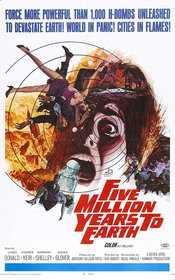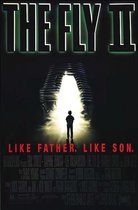Our editor-in-chief Nate Yapp is proud to have contributed to the new book Hidden Horror: A Celebration of 101 Underrated and Overlooked Fright Flicks, edited by Aaron Christensen. Another contributors include Anthony Timpone, B.J. Colangelo, Dave Alexander, Classic-Horror.com's own Robert C. Ring and John W. Bowen. Pick up a copy today from Amazon.com!
Quatermass and the Pit (1967)
The late Nigel Kneale was a visionary and ground breaking writer whose 1950s BBC TV Quatermass serials were not only a massive influence on the likes of Doctor Who and The X-Files, and a big hit with the public, but also one of the first attempts to write dark and scary small screen sci-fi aimed purely at adults rather than children. These were all subsequently remade for the big screen by Hammer Studios, and with Optimum Releasing recently bringing out a freshly remastered Blu-ray disc of the third and final story, Quatermass and the Pit, the time is ripe for a fresh look at a film that has aged very well. Director Roy Ward Baker takes a highly imaginative, ideas-packed script and a strong, charismatic lead character and presents a chilling picture of mob mentality, racism, and mankind's violent tendencies.
While digging at a London Underground station, a group of workmen come across fossilized apes and what looks like an unexploded bomb left over from World War Two. After his new colleague Colonel Breen drags him into investigating the device, Professor Bernard Quatermass discovers the bomb is actually some sort of craft from outer space. As military officials and scientists clash over the implications, violent mobs, driven by mysterious forces, take to the streets on a murderous rampage, and Quatermass finds out some terrifying secrets about the origins of the human race.
Quatermass was a phenomenon in Britain in the mid to late 1950s, as anyone of my parents generation will testify; the success was fueled in part by the novelty of the newly discovered medium of television (sales of sets had been boosted by coverage of the coronation of Queen Elizabeth in 1953) but also by the way the stories tapped into the psyche of a turbulent country caught up in a heady mix of post-war euphoria and cold war paranoia. Hammer Studios adapted the first two stories into hit films, casting Brian Donlevy in the title role, as putting lone American B-movie stars into low-budget British pictures to try to boost international box office returns was common practice at the time. Kneale was unhappy with Donlevy's performance and subsequently refused permission for Hammer to make any more Quatermass films until, by 1967, their resources and prestige had grown to the extent that, not only could they adapt the final tale, a more ambitious and expensive proposal than the previous two, but also cast a British actor in the title rolei.
Despite this, Quatermass is still fundamentally the same character, using his brains rather than his fists to solve problems, and instead of being passive and analytic, it is his determination to act on his ideas and discoveries in the face of hostility and disbelief from the Government and Military that push the story forward. However, compared to the somewhat harsh portrayal we saw from Brian Donlevy, Quatermass as played by Andrew Keir is a more compassionate man, and even a vulnerable one - literally so towards the end of the film, as he eventually succumbs to the madness gripping the rest of the population, and it is left to his friend Professor Roney to make the final sacrifice and save the day.
Although the main focus is on Quatermass, there is still some room left for characterization of the other players in the story. Colonel Breen is as much of an adversary for Quatermass as the Martians. The antagonism between the two men is apparent from the start, with Breen being brought in by the Government to oversee the move from the previously peaceful work of Quatermass and his British Rocket Group into building weapons platforms in outer space. He is obstructive, obstinate, and disdainful, but not just because he is a one-dimensional martinet; rather he is shown to act out of a mix of ambition around Government ministers and insecurity about his authority over the bold and charismatic figure of Quatermass. This eventually leads him to reject everything Quatermass says, despite the mounting evidence, setting in motion the final terrible chain of events. The other pivotal characters, Professor Roney, and Barbara, his assistant, both play crucial roles in the story, helping to unearth the origins of the Martians, and their links to mankind's evolution and the source of a lot of our religions and superstitions; and of course, as previously mentioned, Roney also eventually saves the day at the cost of his own life.
Fascinatingly, the one character that is missing from the story is any kind of tangible villain. The Martians are present throughout, but only as historical figures. They have already landed and carried out their experiments on mankind's ancestors, interfering with their evolution in an attempt to preserve some trace of their race and culture, and, having been, physically at least, wiped out millions of years ago, they won't be coming back any time soon. Once their long dormant psychic energy is unwittingly unleashed on the population of London, transforming them into a bloodthirsty mob, all that our heroes can do is try to deal with the consequences and prevent the human race from destroying itself.
Like the previous two films in the series, the script condenses three hours of television into 100 minutes of film. This is largely achieved by cranking up the pace of the storyline without sacrificing much of the content - in other words, it has many of the same scenes as the original, they just don't go on as long. The plot twists and revelations come thick and fast, but never get overwhelming or confusing, and the tension builds and builds with set pieces that serve to further the story as well as providing some shocking moments, such as a workman being chased through the streets by floating power tools and snake like disembodied cables. What could have been a laughable scene, particularly in a fairly low budget film, works, due to a combination of good special effects (you can't see any wires), tight editing, and some excellent sound design. The sound design in particular is an element of the film that had been entirely overlooked by me until now. Atypical of anything I've heard in Hammer films before, and reminiscent of the work of Louis and Bebe Barron on Forbidden Planet, or Delia Derbyshire and the BBC Radiophonic Workshop, the ominous, rumbling atonal noises and loops kick in whenever there is any malevolent psychic activity from the Martians, adding a further layer of tension and unease.
The only significant criticism to be leveled against Quatermass and the Pit revolves around the scene about two thirds into the film showing what is supposed to be recorded human telepathic flashbacks to the Mars of millions of years ago. Unfortunately, the decision to use cheap, badly made puppets to depict the Martians leaves an end result that is so embarrassingly bad it almost derails all of the excellent work that has gone on before. In the original BBC serial, the effects used were basically the same, but the sequence was shown as a very short series of disorientating fast cuts, which was much more effective, as the viewer was barely able to absorb what was going on. At least, in the film, director Roy Ward Baker does not linger too much on this footage, preferring to focus on the reactions of the Government officials watching.
Thankfully, elsewhere the effects work is good, and in the case of the climactic scenes of destruction across London, very good indeed, with rippling concrete and crumbling buildings all helping to build the feeling of apocalyptic chaos.
These final few minutes provide a tense and genuinely frightening climax. Those affected by the Martian's dormant psychic energy form a citywide lynch mob, using their now unleashed telekinetic powers to lay waste to the creatures they consider inferior, just as the Martians did millions of years ago, and even our hero Professor Quatermass seems to be caught up in it, unable to provide any way out.
The film finishes on what is hardly a happy ending. The immediate threat from the Martians may be gone, but the consequences of their interference remain, leaving large portions of the human race violent, racist, hostile to, and fearful of anybody different, and possessed of a frenzied herd-like mentality. The original TV show was broadcast in the UK just months after race riots had broken out in Nottingham and London, while the film was released in the US in the middle of a wave of racial violence sweeping the country. Watching Quatermass and the Pit, just months after the TV news channels were filled with scenes of English cities ablaze and under siege from rioting mobs, its message still seems eerily relevant. Whatever their origins may be, the dark parts of the human psyche unearthed by Professor Quatermass are still very much with us.
iInterview with Nigel Kneale, Starburst magazine Issue 58








